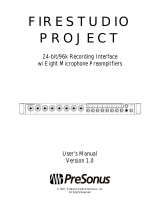
3 Tutorials
3.2 Input Gain Setting
Eris™ Series E5 and E8
Owner’s Manual
3.2 Input Gain Setting
The best place to start is to set the Input Level control at its
unity gain position (labeled “U”). That means the level of the
signal reaching the amplifier is the same as the level of the
signal entering the monitor’s input. This ensures a good, strong
signal level without amplifying any extraneous noise. Make
sure that the gain controls on your audio source have been
optimized for maximum signal level and minimum noise. This
process is called “gain staging,” and you can learn about it from
many online sources. You should always set the Input Gain on
your Eris monitor so that all other level controls in the system
needn’t be turned way up or way down to achieve a
comfortable listening volume.
If setting the input gain to Unity is unsatisfactory, you can
try different settings, but remember that it’s better to avoid
settings above U if possible. If the volume is too loud at
unity gain, feel free to turn the Input Gain control down
a bit—but not so far that you have to crank your audio
source’s output level to its maximum setting. If you set it
too low, you’ll have to crank your audio source’s output
level way up, which will increase the audible noise from
your source signal. If you set it too high, any noise in the
signal will be amplified, which you don’t want, either!
Again, if you properly gain-stage your audio source, setting
Input Gain to U or slightly lower should work fine.
Once the monitor’s Input Gain control is set, leave it
alone; don’t use it as a system-volume control. Leave
that job to your audio device’s output-level control.
3.3 Equalizer Setting Suggestions
The Eris E44/E66 provides three EQ controls in its Acoustic
Tuning section: High, Mid, and Low Cutoff. (There’s also
an Acoustic Space control, which is covered in the next
section.) In general, setting the High control to 0 (no boost
or cut) will produce the best results. However, if the sound
is generally too bright or shrill, try turning this control down
below 0; if the sound is too dull and lifeless, try turning it
up above 0. It’s always better to cut than to boost and to
use the smallest cut or boost needed to get the job done.
The Mid control is a mid-frequency peak filter that boosts
or cuts frequencies centered on 1 kHz and extending
about one octave above and below that frequency. Again,
setting this control to 0 will generally produce the best
results. If you want to emulate a car stereo, try turning it
down below 0 to approximate the common “smiley face”
E66
RCA
Unbalanced
Balanced
ACOUSTIC
SPACE
-4dB
-2dB
0dB
Flat
80Hz
100Hz
LOW
CUTOFF
100-120V~,50-60Hz,T2AL
220-240V~,50-60Hz,T1AL
160W
POWER
AC SELECT
ACOUSTIC TUNING
INPUT
-6dB
+6dB
MID
HIGH
-6dB
+6dB
INPUT
GAIN
MIN
MAX
U
ACOUSTIC
SPACE
-4dB
-2dB
0dB
LOW CUTOFF
MID FREQ
HIGH FREQ
ACOUSTIC SPACE
-4dB
-2dB
0dB
20 800Hz
-6dB
+6dB
0dB
10kHz
-6dB
+6dB
0dB
1kHz
0dB
-3dB
Flat
80Hz
100Hz





















